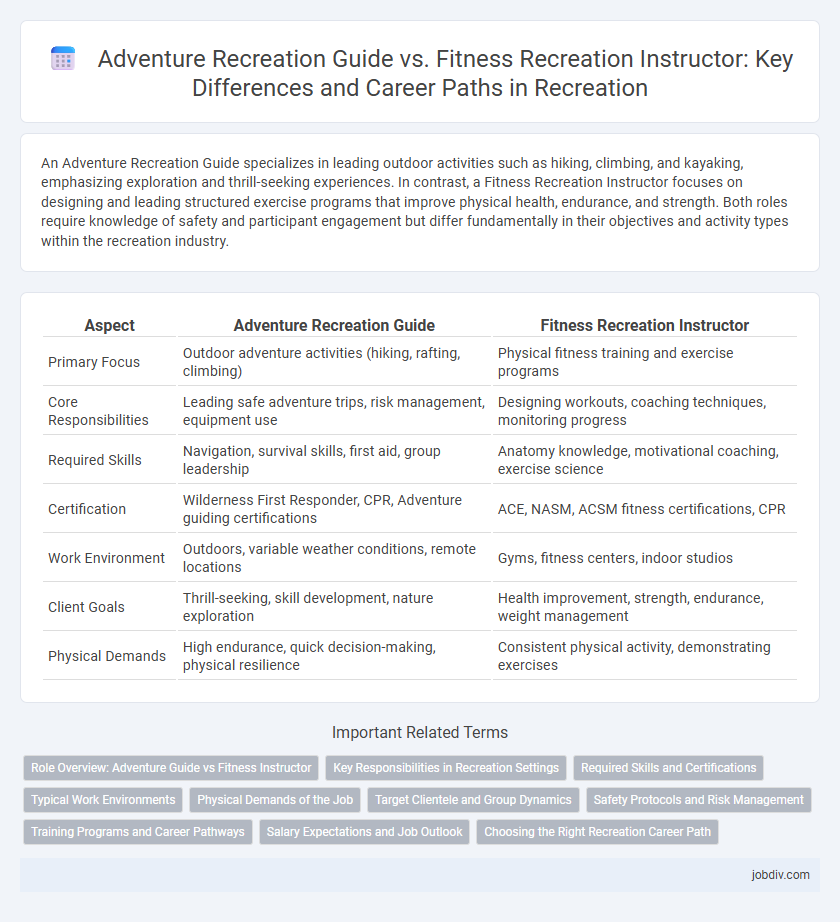An Adventure Recreation Guide specializes in leading outdoor activities such as hiking, climbing, and kayaking, emphasizing exploration and thrill-seeking experiences. In contrast, a Fitness Recreation Instructor focuses on designing and leading structured exercise programs that improve physical health, endurance, and strength. Both roles require knowledge of safety and participant engagement but differ fundamentally in their objectives and activity types within the recreation industry.
Table of Comparison
| Aspect | Adventure Recreation Guide | Fitness Recreation Instructor |
|---|---|---|
| Primary Focus | Outdoor adventure activities (hiking, rafting, climbing) | Physical fitness training and exercise programs |
| Core Responsibilities | Leading safe adventure trips, risk management, equipment use | Designing workouts, coaching techniques, monitoring progress |
| Required Skills | Navigation, survival skills, first aid, group leadership | Anatomy knowledge, motivational coaching, exercise science |
| Certification | Wilderness First Responder, CPR, Adventure guiding certifications | ACE, NASM, ACSM fitness certifications, CPR |
| Work Environment | Outdoors, variable weather conditions, remote locations | Gyms, fitness centers, indoor studios |
| Client Goals | Thrill-seeking, skill development, nature exploration | Health improvement, strength, endurance, weight management |
| Physical Demands | High endurance, quick decision-making, physical resilience | Consistent physical activity, demonstrating exercises |
Role Overview: Adventure Guide vs Fitness Instructor
An Adventure Recreation Guide leads clients through outdoor activities such as hiking, rock climbing, and white-water rafting, emphasizing safety, navigation, and environmental awareness. A Fitness Recreation Instructor designs and implements exercise routines to improve physical health and wellness, often in gym or studio settings. Both roles require specialized knowledge, but the Adventure Guide focuses on risk management and outdoor skills, while the Fitness Instructor centers on exercise science and client motivation.
Key Responsibilities in Recreation Settings
An Adventure Recreation Guide specializes in leading outdoor activities such as hiking, rock climbing, and rafting, ensuring safety and providing expert knowledge on equipment and natural environments. A Fitness Recreation Instructor focuses on designing and implementing exercise programs, promoting physical health, and motivating participants in gym or recreational facility settings. Both roles require strong communication skills and the ability to adapt activities to individual skill levels and group dynamics within recreational environments.
Required Skills and Certifications
Adventure recreation guides require strong navigation, survival, and risk management skills, along with certifications such as Wilderness First Responder (WFR) and CPR/AED. Fitness recreation instructors need expertise in exercise physiology, group fitness leadership, and nutrition, holding certifications like ACE Personal Trainer or NASM Certified Fitness Trainer. Both roles demand excellent communication and safety management abilities tailored to their specific recreational activities.
Typical Work Environments
Adventure Recreation Guides typically work in outdoor settings such as national parks, wilderness areas, and adventure resorts, where they lead activities like hiking, rock climbing, or kayaking. Fitness Recreation Instructors are often found in gyms, community centers, or dedicated fitness studios, focusing on structured exercise programs and group fitness classes. Both roles require adapting to their environments to ensure participant safety and engagement.
Physical Demands of the Job
Adventure Recreation Guides face intense physical demands, including navigating rugged terrain, carrying heavy equipment, and managing emergency situations in outdoor environments. Fitness Recreation Instructors engage in structured physical activities that require stamina, strength, and flexibility, often demonstrating exercises and motivating participants in gym or studio settings. Both roles demand high levels of physical fitness, but Adventure Guides experience more unpredictable, endurance-focused challenges compared to the controlled, repetitive physical exertion of Fitness Instructors.
Target Clientele and Group Dynamics
Adventure Recreation Guides primarily serve thrill-seekers and outdoor enthusiasts who look for challenging activities like rock climbing, hiking, or white-water rafting, often leading small, tight-knit groups for personalized and dynamic experiences. Fitness Recreation Instructors target health-conscious individuals or fitness groups aiming to improve physical wellness through structured exercise routines, managing larger groups with consistent, routine-based interactions. Group dynamics in adventure settings emphasize adaptability and quick decision-making under pressure, while fitness settings focus on motivation, technique correction, and sustaining long-term engagement.
Safety Protocols and Risk Management
Adventure recreation guides rigorously implement safety protocols such as equipment checks, environmental assessments, and emergency response training to manage inherent risks in activities like rock climbing and white-water rafting. Fitness recreation instructors prioritize injury prevention through proper exercise techniques, warm-up routines, and facility safety to minimize accidents during fitness classes and gym workouts. Both roles require comprehensive risk management plans tailored to their specific recreation settings to ensure participant safety and compliance with industry standards.
Training Programs and Career Pathways
Adventure Recreation Guides undergo specialized training in outdoor skills such as rock climbing, wilderness navigation, and safety protocols, preparing them for careers in ecotourism, outdoor education, and expedition leadership. Fitness Recreation Instructors typically complete certifications in exercise science, group fitness, and personal training, leading to roles in gyms, wellness centers, and corporate fitness programs. Career pathways for Adventure Guides emphasize experiential learning and risk management, while Fitness Instructors focus on health promotion and individualized workout program development.
Salary Expectations and Job Outlook
Adventure Recreation Guides typically earn an average salary ranging from $35,000 to $55,000 annually, with job growth projected at 8% due to increasing demand for outdoor and experiential activities. Fitness Recreation Instructors have a median salary of approximately $40,000, with opportunities expanding by 10% as health and wellness awareness rises. Both careers offer dynamic environments, but Fitness Recreation roles demonstrate a slightly stronger job outlook driven by the growing fitness industry.
Choosing the Right Recreation Career Path
Adventure Recreation Guides lead outdoor activities like hiking, kayaking, and rock climbing, requiring strong skills in risk management and environmental awareness. Fitness Recreation Instructors design exercise programs focused on improving physical health and wellness within community or recreational settings. Choosing between these careers depends on your passion for either dynamic outdoor experiences or structured fitness training, as well as your preferred work environment and skill set.
Adventure Recreation Guide vs Fitness Recreation Instructor Infographic

 jobdiv.com
jobdiv.com